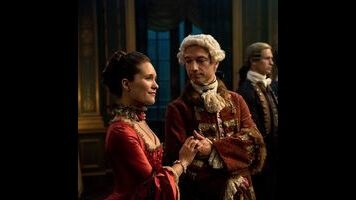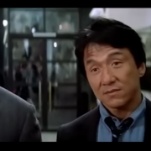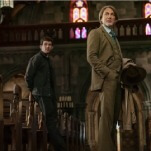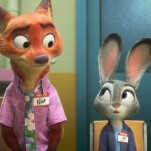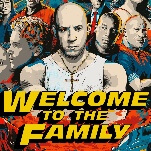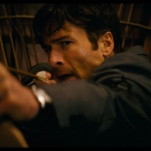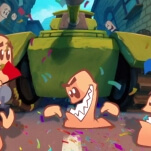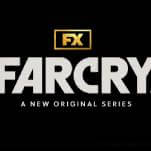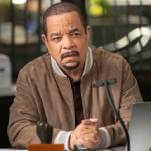Someone is trying their hardest to destroy Claire. The top suspect at the moment is Comte St. Germain, the man whose ship Claire had destroyed because of a smallpox contamination in the season premiere. He spends “La Dame Blanche” the same way he has since he was first introduced on the show: lurking, leering, delivering ominous but vague threats. Whether it’s him or not—and Claire seems to think it is—someone has it out for Claire. In the beginning of the episode, she falls ill from the not-quite-lethal poison Master Raymond sells in his apothecary. Later, she and Mary are attacked by masked men on their way home from the hospital. One of the attackers rapes Mary. Claire emerges physically unharmed but psychologically wounded.
Dramatizing sexual violence is a tricky, knotty thing. There isn’t a simple set of rules for when it’s acceptable and when it isn’t. Writers and showrunners often hide behind the argument that it’s okay to portray rape when sexual violence is simply a dark reality of their show’s world. Outlander takes place in a specific time and place where there are barely legal protections for women who have been raped. This isn’t the first time Claire has faced the threat of rape. It’s not the first time the show has depicted sexual violence either. I think the biggest question writers should ask themselves when it comes to depicting rape is why. And there shouldn’t necessarily be an easy or short answer to that question. Was Mary raped merely as a way to advance the plot? Has this character, who was before only characterized by her innocence and her shyness, only been rendered a brutalized victim for the sake of the season’s plot? Only to establish St. Germain as a more serious threat? Only to affect the other characters’ arcs? I can’t really answer any of those questions right now, but they’ll certainly be on my mind throughout the rest of the season. Outlander has overall been powerful, smart, and manifold in its exploration of Jamie’s trauma and how it shapes the character’s psyche. Will Mary be afforded that same level of depth even though she isn’t one of the show’s protagonists?
The violent scene casts a dark shadow over “La Dame Blanche.” The episode soldiers on after, not allowing viewers a chance to breathe or process. Claire and Jamie are at a crucial point of their plan, and there’s barely any time to take Mary—unconscious from the shock and pain of it all—up to a bedroom to rest and heal. Claire, at least, reacts noticeably to the discomfort of moving forward despite what has happened. Before leaving Mary to go down to her dining hall full of waiting, unknowing party guests, she tells herself, outloud, to breathe. She tries her best to collect herself. Outlander’s depiction of violence is never really for show or to simply build the world. It affects the characters on a deeply psychological and emotional level. Outlander doesn’t depict horrors merely to horrify.
And that is very easy to see in the way Jamie continues to grapple with the pain he still endures from when Randall raped him. In “La Dame Blanche,” Jamie opens up to Claire about Wentworth in more detail than ever before, attempting to find the right words to describe an indescribable state of being. Randall severed Jamie from his soul, left him alone, vulnerable, drifting. He explains all this in a superbly written and acted scene, Sam Heughan digging deeply into the character’s complicated inner turmoil. The writing in “La Dame Blanche” gives equal depth and significance to both Claire and Jamie’s emotions. That’s what makes that scene and the one that follows—of Claire and Jamie reconnecting sexually for the first time in months—so moving. Both struggle, in different but equally complex ways, to figure out what Jamie’s trauma means for their relationship. Claire feels alone in her pregnancy, unwanted by Jamie. She wants so desperately to understand what’s going on in his mind, but she can’t. And Outlander doesn’t romanticize one bit of that. Caitriona Balfe and Heughan hurl themselves into tumultuous and visceral performances.
Sex has been very noticeably absent from the first few episodes of the season. Outlander built a reputation for its steamy, long, pleasure-focused sex scenes in season one. But the lack of sex scenes in the season so far only highlights how narratively significant sex is on this show. As with violence, Outlander does not merely show sex for the sake of sex. The sex scenes aren’t a tour in voyeurism or gratuity. They’re intricately tied to the story and, most importantly, to the emotional states of the characters. Jamie and Claire haven’t been having sex, because Jamie has found himself unable to get physically intimate with Claire without having terrorizing flashbacks to Randall.
But something changes within Jamie when Claire tells him that Randall is still alive. It’s not the reaction she expected: Jamie doesn’t crumple in despair or agony. Still, even though Jamie has a sudden bounce in his step, his reaction is undeniably unnerving. He’s joyful that Randall is alive, fueled by a thirst for revenge. He’s rejuvenated with new purpose, new control. He wants to be the one to kill Randall himself. And that newfound zeal also brings back his sex drive. Again, it’s a bit unnerving. But it comes from a very grounded and well written emotional place. And so Claire and Jamie intimately reconnect through sex. It’s a beautifully shot scene that throws dark blues over Claire and Jamie’s bodies. Heughan and Balfe are as nuanced and visceral here as they are in the scene that comes before. There’s a strong sense of naturalism to the sex scene. And it’s all still colored by the characters’ emotions unearthed in the prior scene. It’s strong, character-driven storytelling.
There’s so much more that happens in “La Dame Blanche,” and in fact, one of the drawbacks of the episode is that it takes on a bit too much. I know that Outlander sometimes gets criticized for being too slow, but as I said in my review last week, I find it to be more thoughtful than tedious. The writers don’t hesitate to really let a scene breathe, and that leads to some wonderful character moments. For example, Claire and Louise have a great, understated scene in “La Dame Blanche” that not only further develops their relationship to one another but also taps into Claire’s role as time-traveling feminist. Knocked up by her lover, who turns out to be Prince Charles, Louise wants an abortion. Claire’s willing to help, but she also doesn’t have any access to safe tools and warns Louise of the risks, ultimately helping her come up with a plan that will allow her to keep the baby, her marriage, and her reputation. It’s a simple conversation between two friends, but the scene works on multiple levels. But “La Dame Blanche” brims with so much action and so many new plot developments that it overwhelms, which diminishes the potency of some of the bigger emotional moments. It’s not that there are necessarily scenes that seem inessential; there’s just so much going on. Claire’s days are starting to seem impossibly long, and it’s getting trickier to tell exactly how much time passes week-to-week in the show’s timeline.
It’s the subtle, drawn-out, anxious moments that “La Dame Blanche” really thrives on: Claire’s panicked utterances to herself after witnessing a horrific assault, Jamie’s deeply personal confessions, their tender sexual reunion, the way the prince’s lips linger a little too long on Louise’s hand, causing her to stir. Claire wonders, after she and Jamie concoct a plan to exploit the prince and Louise’s affair in the name of their plan, if they are bad people. Jamie assures her that they are doing a bad thing for the right reasons, and she points out that’s what bad people probably say, too. That’s the thing about Outlander: Even the scenes centered on Jamie and Claire’s political schemes dig into deeper meaning. It’s not just about the plan but about what it means for the characters and their relationships.
Stray observations
- Master Raymond foretells of Claire’s reunion with Frank. I’m starting to wonder if Outlander showed too much of its hand with the season premiere. I’m not yet sure what the show really gains from the dramatic irony of us knowing she does indeed return to her time.
- I’m also getting very confused by the timeline, because shouldn’t Claire have looked way more pregnant in those scenes with Frank from the season premiere? Her baby bump is showing in the timeline we’re currently in, so why wasn’t it then?
- To Louise, being sent to a convent is a fate worse than being arrested.
- Andrew Gower is giving a truly weird but fascinating performance as the prince, who Outlander characterizes as an unhinged and delusional religious zealot.
